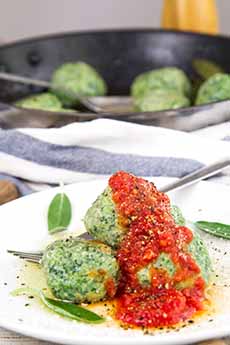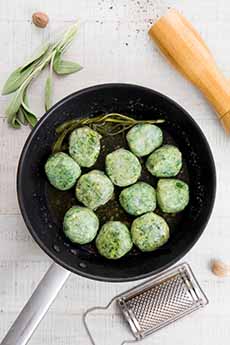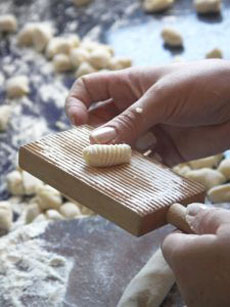TIP OF THE DAY: Gnudi, Naked Ravioli
|
|
Do you like gnocchi, ravioli and tortellini, but not the carbs? Get to know gnudi: It’s the filling without the pasta or the potatoes. So essentially, gnudi is a dumpling: It has no pasta wrapping. Essentially, gnudi are a low-carb way to enjoy pasta, with the delicious filling of ravioli, but so much more of it. Gnocchi (pronounced NYOH-kee), the Italian word for dumplings, are chewy pillows that are shaped into little balls. They are most often made with white or sweet potatoes, then boiled, baked or fried. They can be flavored: basil, spinach, tomato and saffron are classic; and beet, butternut squash, carrot and pumpkin—perhaps with goat cheese instead of ricotta—can be found on menus. Gnocchi are served with butter and grated Parmesan cheese or a sauce. See a photo of plain gnocchi, photo #7 below. Gnudi (pronounced NYOO-dee, also with a silent “g”) derives from nudi, which means nude in Italian. They are much lighter than gnocchi and much easier to make. Gnudi is actually the English word for the Italian “nudi” (naked). Why the extra “g?” Our best guess: The English didn’t want to call something “nudie” so they added the silent “g” of “gnocchi.” A traditional Tuscan ricotta dumpling, gnudi consist of pasta filling—what you find inside tortellini or ravioli—shaped into small, flattened balls without any dough. In fact, they are also referred to as nude ravioli or naked ravioli: the filling without the shell. The dumplings are sautéed with brown butter and sage sauce, sprinkled with Parmigiano Romano or Pecorino Toscano cheese. Outside of Tuscany, the ricotta is often mixed with spinach and parmesan, to create gnocchi di ricotta e spinaci. The gnudi are sautéed or baked. You can serve them as plain—simply sautéed in olive oil or butter, with grated cheese or tomato sauce [photo #1]. Or go as sophisticated as you like, like the truffle-topped gnocchi in truffle sauce in photo #2. Caviar, anyone? Without heading to Italy to hunt through historical archives, it’s tough to find out much on the origin of gnudi. According to Oretta Zanini de Vita in the Encyclopedia of Pasta, they date from at least the late 1200s, and predate stuffed pasta [source]. Pasta-followers may recall from our history of pasta that the pasta Marco Polo brought back from China—he set out in 1271 and returned in 1295—is believed to have been “pillow pasta” like ravioli, the Italian spin on Chinese wontons. Thus, if gnudi did pre-date stuffed pasta, they predated Marco Polo’s introduction of it. But, it’s apples and oranges: Even though they end up on pasta menus, gnudi are dumplings, not pasta. Thanks to Chef Johnny Gnall for sharing his easy gnudi recipe. Ingredients 1. Make the sauce. Melt butter in a sauté pan and cook until it begins to turn golden brown (do not overcook or the butter may burn). Add sage; stir and and remove from heat. Add lemon juice and set aside. 2. Remove water from spinach. It’s important that you remove most of the water from your spinach, or the dough will never come together. Press the pureed spinach against a mesh strainer and then hang it to drain for 30 minutes. 3. Combine ricotta and spinach. Thoroughly incorporate, then add the beaten egg, a couple of pinches of salt, and Parmesan. Mix well. Taste a bit of your mixture and adjust with salt and pepper as necessary. 4. Add the flour. The actual amount of flour may vary slightly depending on anything from the moisture content of the ricotta to the moisture in the atmosphere. Too much flour could make the gnudi dense and heavy; not enough flour, and the gnudi might fall apart. Therefore, bring everything together and test the consistency by dropping a spoonful into some boiling water. If it holds its general shape and doesn’t come apart in the water, you’ve nailed it! 5. Shape the gnudi. Using two spoons, form your gnudi into quenelles (oval shapes) and lay them on a cookie sheet, tray or clean surface. One they are ready to go, drop them into seasoned boiling water in batches. Make sure you don’t overcrowd your pot, or the gnudi will jostle one another and likely fall apart. Once the dumplings float to the surface, they should take about a minute to cook. Exact cooking time may vary, so it do a tester or two and see which time suits your taste. 6. Sauce and serve. Right before serving, return the brown butter to the heat and add the Parmesan cheese. Stir to blend, then add the gnudi and toss to coat. Serve immediately. Ingredients 1. Wash and dry sage and remove stems. Be sure that the leaves are thoroughly dry before frying (when we don’t have time to air dry, we use a hair dryer!). 2. Heat oil in a small pan over medium-high heat. 3. Fry sage leaves until crisp, 2–3 seconds. Do not crowd in the pan; fry in batches if necessary. 4. Transfer to paper towels to drain and sprinkle with salt. Reserve until ready to serve. Check out the delicious options in our Pasta Glossary. |
|
|
|
||
|
|




